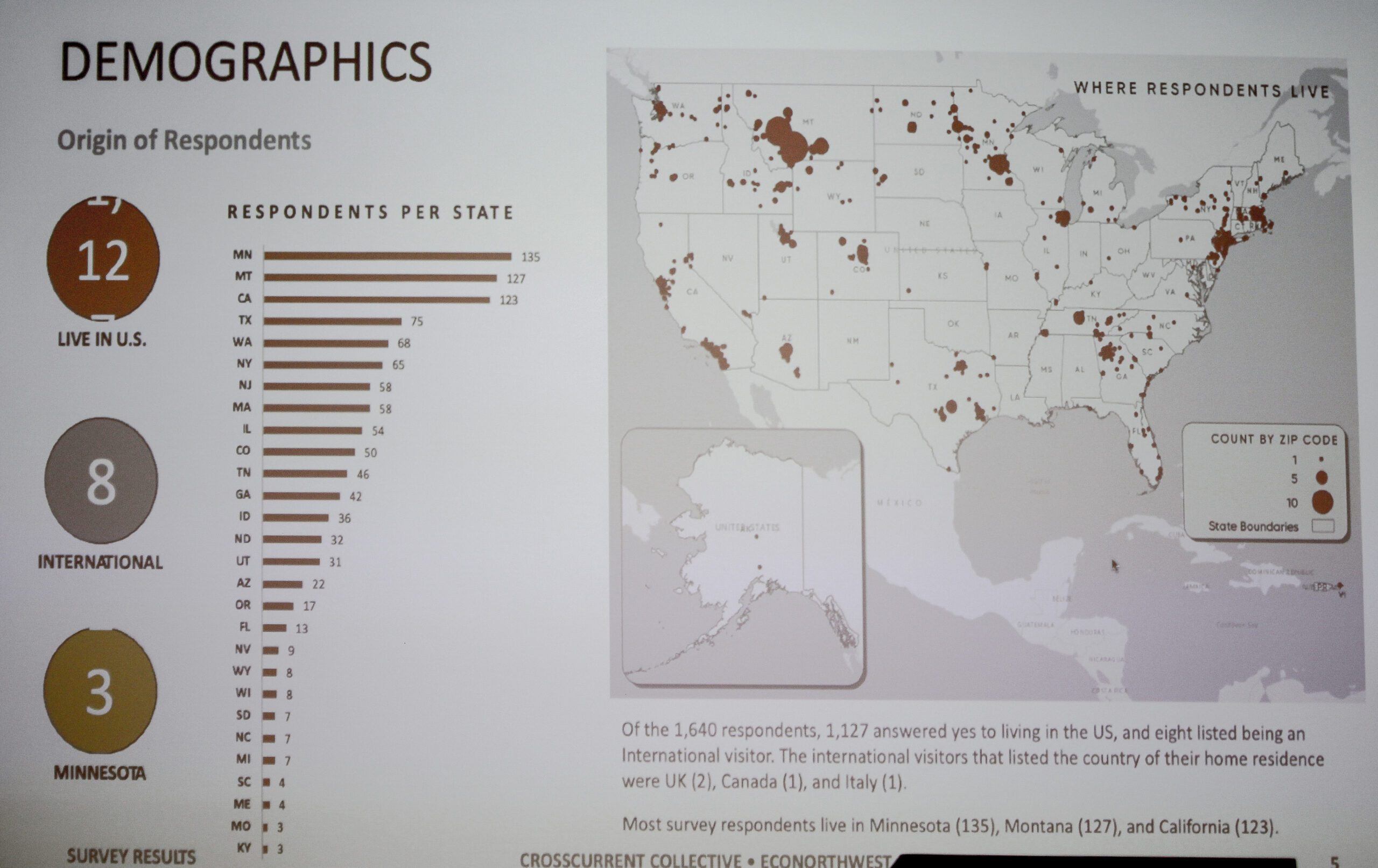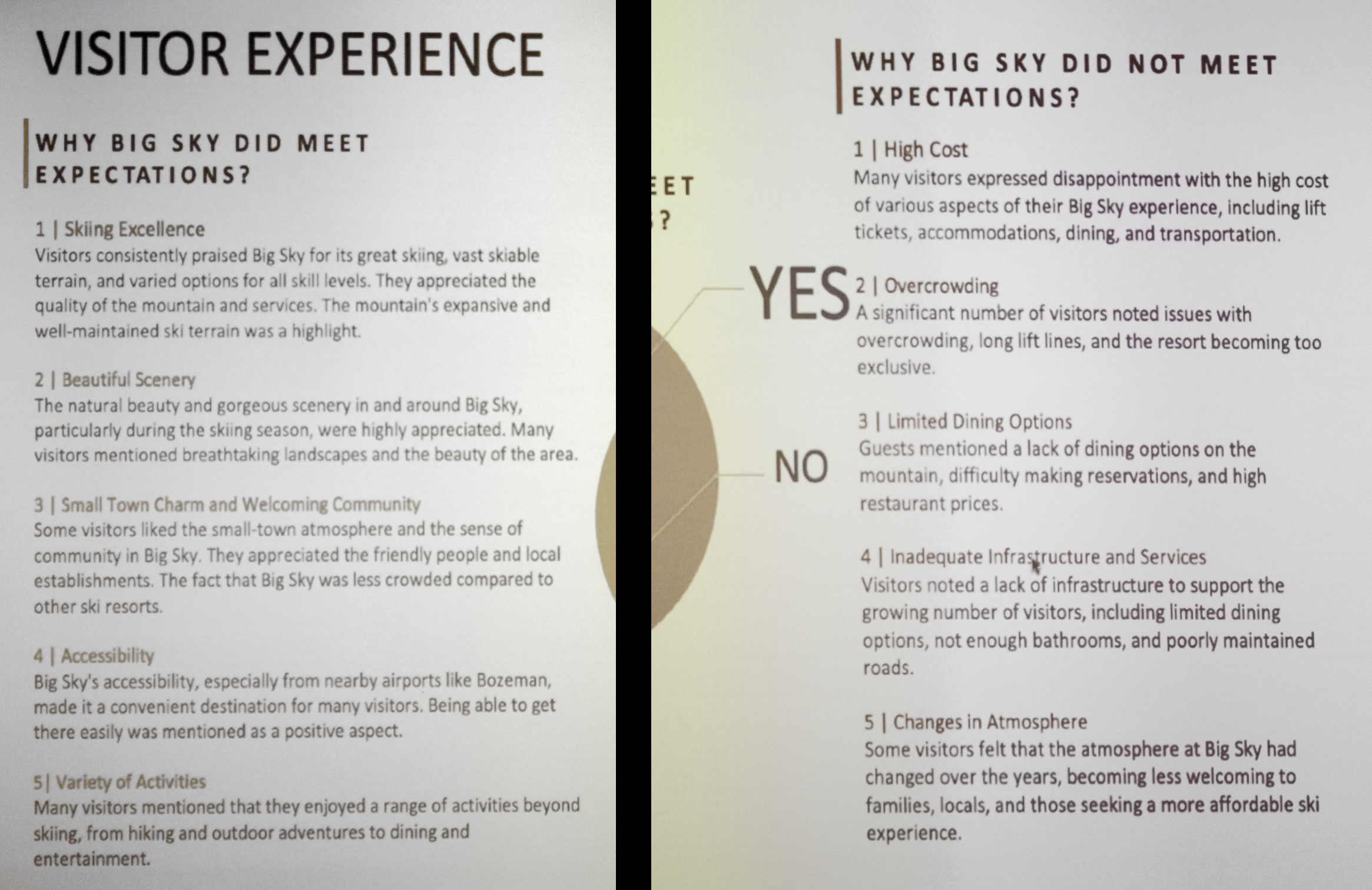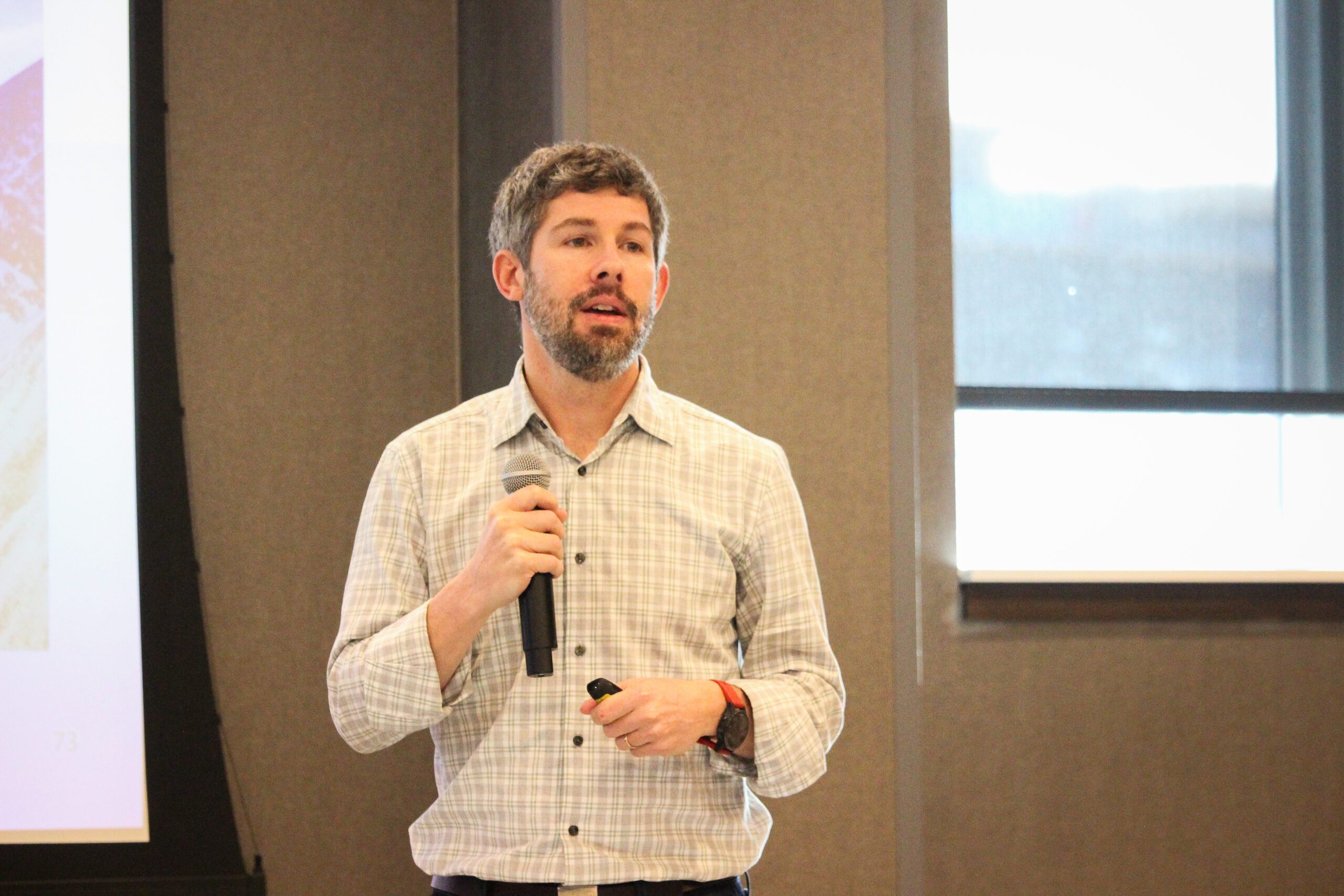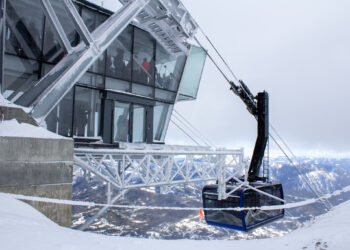‘No need to panic’ about holiday weeks despite dry start to winter; visitor survey shows desire for activities beyond skiing
By Jack Reaney ASSOCIATE EDITOR
Snow might be playing catch-up this December, but lodging projections suggest an insignificant effect on expected holiday business.
On Dec. 5, Visit Big Sky—the destination marketing affiliate of the Big Sky Chamber of Commerce—hosted a public discussion of this winter’s tourism outlook. CEO Brad Niva shared results from a recent survey of Big Sky’s visitors, Big Sky Resort shared booking trends and marketing insights, and market researcher Steve Halasz shared lodging and economy data.
Halasz, founder and CEO of Portland-based Blue Room Research, pointed out that after a 2022 high water mark in the post-COVID travel era, the industry is coming “back to planet Earth.”

For Big Sky lodging occupancy, Halasz summarized his expectations for the entire winter: at, or slightly below last year.
And for average daily room rate: at, or slightly above last year.
He showed booking data (pulled on Nov. 15) for Airbnb and VRBO rentals, and summarized that this winter projects fewer bookings than last year.
“Two exceptions being Christmas week and New Year’s week,” he said. During those times, occupancy should beat 2022, and room rates will be similar, with a slight bump around the New Year.
Halasz noted that throughout the winter, the slight downswing is not unique to Big Sky—it’s happening to almost every ski destination and resort nationwide. Coupled with the observation that more visitors are waiting longer to book, the actual bookings will likely rise throughout the winter.
“No need to panic, but I do see a slight slowing with regard to occupancy,” Halasz said of Airbnb and VRBO rentals.
A second dataset (pulled Nov. 29) for property management companies—12 businesses covering 1,400 units including Big Sky Resort, Montage Hotel, The Wilson Hotel and Moonlight Basin—showed similar trends, but even closer to last winter.
“If you look at 2022 versus 2023, all the numbers are almost neck-and-neck… So I expect to see very similar trends from this year and last year,” Halasz said.
Average daily rate agrees: slightly down based on current data, but with a similar curve projected throughout the winter months.
For this second dataset, Christmas week should beat last year for both occupancy and daily rate. Occupancy is down for the New Year, but only slightly.
“Overall, I would expect Christmas week and New Year’s week to be pretty strong… compared to last year,” Halasz summarized to EBS in a follow-up interview.
His research also tracks credit card spending for in-person transactions with Visa cards—the dataset is limited, but a strong sample size and good proxy for market health, he said. The numbers have improved every year since 2020, with almost parallel curves.
“2023: nothing but up and to the right,” Halasz observed. “Obviously inflation adds a little bit of effect here, but consumers are coming here, they’re spending more money, they’re doing more. So really good, strong spending trends.”
Visitors account for roughly 80% of total spending during peak seasons, compared to 20% by residents—a cardholder’s home location is determined by their Visa billing address. Halasz pointed to Bozeman as a major market.
“It’s a lot of small transactions, they’re not staying as long and spending [as much] money, but they are spending a heck of a lot of money. They spent almost $20 million in market year-to-date,” Halasz said. His 2023 data shows that Bozeman credit cards account for the vast majority of spending in Big Sky—even compared to top inbound markets like New York, Los Angeles and Chicago.
In a potential economic downturn, Halasz is not worried about major cities—most of Big Sky’s consumers are largely immune to economic downturns, he said—but he’s worried about Bozeman where Big Sky visitors might be hit harder.
In a tough economy, “Instead of [coming to Big Sky] maybe three days a year to ski, they are going to come maybe two or one,” Halasz suggested.
Visitor survey reflects high costs for a high-quality vacation; new visitors aren’t all here to ski
Brad Niva sees tremendous growth—Big Sky now has 292,000 annual visitors, by Visit Big Sky’s estimate. About 87% stay overnight.
“We are really a cash cow when it comes to the taxes collected and our impact across [not just] Big Sky but Gallatin County and the whole state. So we continue to be a phenomenal product for the state of Montana,” Niva said.
Between 2019 and 2022, Big Sky has seen a 93% increase in visitor spending within the resort area district boundary, Niva said. Big Sky is also Montana’s largest collector of lodging tax—not due to Big Sky’s number of hotel rooms, but “we do charge more so our collections are higher,” he explained. Bozeman and Billings follow Big Sky in lodging tax collections, respectively.
Niva said Big Sky only has about 400 hotel rooms, but close to 1,300 short term rentals.
“We continue to see high demand for hotel rooms, but short-term rentals are really the driving force to help us carry the load of what our lodging needs are,” Niva said.
Niva’s presentation summarized a tourism survey sent to visitors in the spring—residents filled out a related survey and those separate results were discussed in November. The final report will be public soon.
Visit Big Sky will look to balance tourism throughout the year—survey says, about 86% of Big Sky’s guests come in the winter, 39% in the summer, 20% in the spring and 13% in the fall (percentage overlaps occur from those who visit multiple seasons).
Niva did pull one statistic from the survey of more than 600 residents: most locals want to see increased visitation in the spring and fall, and less during the summer and winter seasons.
“So instead of these ups and downs, I call it the roller coaster… Our goal is to start increasing our spring occupancy and increase our fall,” Niva explained.
Based on visitor feedback, one hospitality challenge is the perception of high cost.
“We hear comments, we read our comment cards, we look online [at] what people are saying,” and visitors are expressing that Big Sky is expensive, Niva said. For lodging, 19% of surveyed visitors believe Big Sky is “very expensive,” and 37% say “expensive.” With more luxury hotels being built, and the existing supply-demand pressure—relatively few hotel rooms translate to high demand and price—Niva expects that trend to continue.
Cost of activities—including lift tickets, fly fishing, horseback riding and Yellowstone tours—and cost of dining followed a similar trend, with at least half of visitors perceiving “expensive” or “very expensive.” About half found costs to be reasonable.
Despite the expenses and challenges, “we still have some really happy customers… We’re still delivering a great experience,” Niva said. He suggested that quality skiing brings guests back, scenery is spectacular, and small-town charm and welcoming community have gotten kudos.

Some visitors reported overcrowding, although Niva questioned whether that’s usually accurate.
Visitors also reported a desire for more dining options. They cited a lack of bathrooms and poorly maintained roads.
In addition, Niva hears comments on the change the area has seen.
“There are families who have been doing Big Sky for 36 years, 40 years, and of course, the town has changed,” he said. “And there are a lot of people who don’t like that.”
Niva said Visit Big Sky will keep that feedback in mind, “and how can we make sure that we continue to manage tourism and grow it in the right direction.”
The visitor survey showed that many are new to Big Sky, and those first-time visitors are more likely to return than a 10-time visitor, by comparison.
Consistent visitors spread their time between skiing and snowboarding, and visit local restaurants and shops. New visitors, by comparison, might not hit the slopes every day, drawn to fly fishing, Yellowstone National Park or the Big Sky Farmers Market, Niva suggested.
“Maybe our clientele is diversifying a little bit and we’re not just a ski destination anymore, we are also a winter and summer destination,” Niva said.
Above all, 56% of respondents said they would certainly be back. Another 16% said their return is likely.
Of the 28% disinterested in returning, many cited finances and inaccessible costs. Other factors include crowding, loss of “the Montana experience,” need to improve customer services and to reduce growth or make it sustainable.
Niva pointed out that many visitors simply want to explore other destinations as the world opens up.
“We want to acknowledge that and we may have to work a little harder on our marketing to keep pulling people [back to Big Sky],” Niva concluded.
Big Sky Resort expects healthy 50th winter
Yann Benjamin, Big Sky Resort VP of marketing and sales, said he can corroborate much of Halasz’s presentation.
“All things considered, we’re in a very healthy state,” Benjamin said.

Aggregating the entire winter, the resort is up in lift tickets and Ikon pass reservations, up in pass sales, up in room rates and occupancy, Benjamin summarized.
He shed light on key geographical markets.
“We’ve got a huge visitation base out of the West Coast. They continue to be a dominant market for us, driven both by lift tickets and Ikon passholders,” Benjamin said. “And then we see a huge Northeastern contingent.”
He explained that Big Sky Resort is growing its visitor market from Texas, and regional stakeholders—including the resort—are pushing for a direct flight between Bozeman and Florida.
“We see a huge ski market out of Florida… And our biggest challenge as a community is direct air access to Bozeman… And if we can unlock that potential, whether it’s central Florida, southern Florida, I think we could see some huge gains as a community,” Benjamin said.
Benjamin was proud to announce that Big Sky Resort has reached a winter staff of 2,000 winter for the first time. A record 68% of this winter’s team is returning, and more than 100 are spending at least their 10th season with Big Sky Resort.
“Which is wild to think,” Benjamin said. “And even when you look at 15 and 20 [years], there are still dozens.”
Big Sky Resort’s formal 50th anniversary party will be held on Saturday, Jan. 6. Music, performances and some surprises are in store, Benjamin said.















